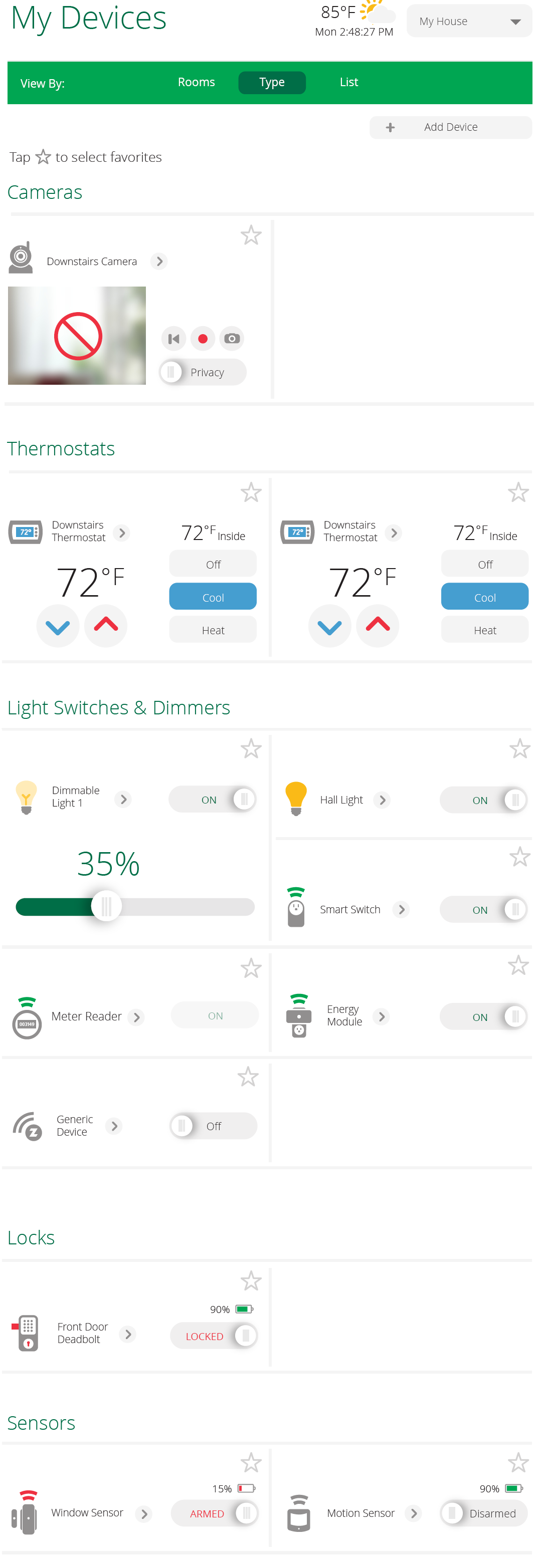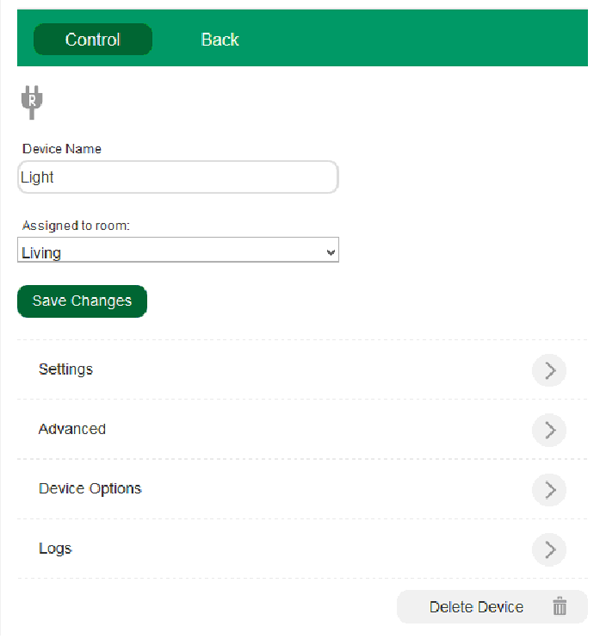Click on the Devices tab to see all of the Devices in your Vera system, to control and organize your Devices, and to add new Devices to your system. Here you can also confirm that they're working properly, and set rules of behavior (such as notifying you with texts, etc.) for them, individually or in groups.
View Devices
When you select Devices you will see ALL the Devices in your system. Unlike My Favorites on the initial Dashboard screen, each and every Device in your system is included here. (My Favorites only shows those Devices you've designated as favorites.)
You can View Devices three different ways:
· By Device Type (Lighting, Door Locks, etc.)
· By Room
· Listed with details about power, signal strength and more
The Device Type and Room displays are designed to provide quick access to control the Devices, such as to adjust light levels are change a thermostat setting. Here is what the screen looks like when populated by a number of commonly installed Devices when viewing by Type is selected:

List
When you click on List you'll see all your Devices organized by type, but rather than providing quick access to controls (as in the Type view), the List view shows you several key technical details about each Device. This information includes:
· Battery or AC power status
· Signal strength (for wireless communication with the Vera Controller)
· Is it a Favorite?
Here's what the same set of Devices shown above looks like in List view:

If you want to control settings or setup for any Device, you can do it from this List view by clicking the right arrow

next to the Device you want to adjust.
Controlling Devices
When a Device (like a camera, light switch, sensor, etc.) is properly working in your Vera system, you have control over that device's operation and setup using a set of adjustments located next to the Device in the Type and Room views of all your installed Devices. These adjustments are different for each type of Device -- a thermostat offers temperature settings, for example, while a lamp dimmer has a light level adjustment.
Let's use a Smart Switch as an example. Once you've included this device into your system via the Setup Wizard, you will see its basic functions right away -- in the case of this device, the basic functions are to turn it on or off.

You can add the light switch to your Favorites so it will display under My Favorites on your Dashboard's main screen, for easy visualization and groupings, much like you'd pin something to your bulletin board.

You’ll also see a second button, which looks like an arrow pointing to the right, which will open up the Control Pad for that particular device. Depending on the type of device and the device itself, there will be several setup options that may be configured.
For the example of the SmartSwitch, here is what a configuration screen would look like. Again, there will be different options available depending on each individual device you're setting up.
Don't worry -- you won't have to adjust any of these technical parameters if you're not comfortable with them. We will discuss these functions in a later section. In the meantime, you can see a typical Control Pad screen below:

The next section covers how to Add New Devices to your system.
View Devices
When you select Devices you will see ALL the Devices in your system. Unlike My Favorites on the initial Dashboard screen, each and every Device in your system is included here. (My Favorites only shows those Devices you've designated as favorites.)
You can View Devices three different ways:
· By Device Type (Lighting, Door Locks, etc.)
· By Room
· Listed with details about power, signal strength and more
The Device Type and Room displays are designed to provide quick access to control the Devices, such as to adjust light levels are change a thermostat setting. Here is what the screen looks like when populated by a number of commonly installed Devices when viewing by Type is selected:
List
When you click on List you'll see all your Devices organized by type, but rather than providing quick access to controls (as in the Type view), the List view shows you several key technical details about each Device. This information includes:
· Battery or AC power status
· Signal strength (for wireless communication with the Vera Controller)
· Is it a Favorite?
Here's what the same set of Devices shown above looks like in List view:
If you want to control settings or setup for any Device, you can do it from this List view by clicking the right arrow
next to the Device you want to adjust.
Controlling Devices
When a Device (like a camera, light switch, sensor, etc.) is properly working in your Vera system, you have control over that device's operation and setup using a set of adjustments located next to the Device in the Type and Room views of all your installed Devices. These adjustments are different for each type of Device -- a thermostat offers temperature settings, for example, while a lamp dimmer has a light level adjustment.
Let's use a Smart Switch as an example. Once you've included this device into your system via the Setup Wizard, you will see its basic functions right away -- in the case of this device, the basic functions are to turn it on or off.
You can add the light switch to your Favorites so it will display under My Favorites on your Dashboard's main screen, for easy visualization and groupings, much like you'd pin something to your bulletin board.
You’ll also see a second button, which looks like an arrow pointing to the right, which will open up the Control Pad for that particular device. Depending on the type of device and the device itself, there will be several setup options that may be configured.
For the example of the SmartSwitch, here is what a configuration screen would look like. Again, there will be different options available depending on each individual device you're setting up.
Don't worry -- you won't have to adjust any of these technical parameters if you're not comfortable with them. We will discuss these functions in a later section. In the meantime, you can see a typical Control Pad screen below:
The next section covers how to Add New Devices to your system.

Comments
0 comments
Please sign in to leave a comment.